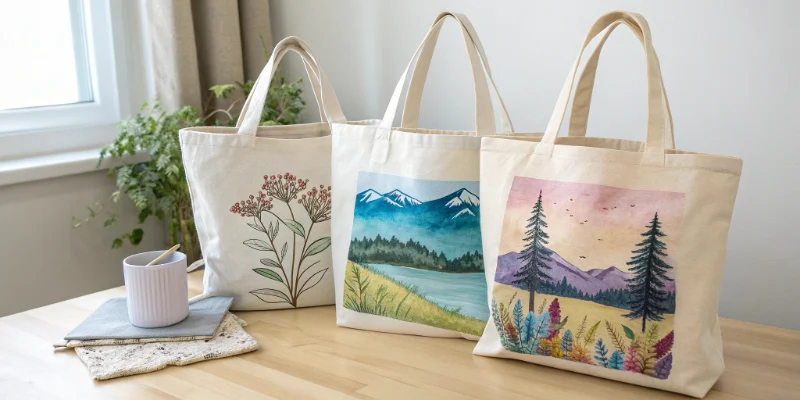Our Academy

When it comes to canvas bags, the choice of fabric plays a much bigger role than most people realize. The texture, color performance, and durability of a bag all depend on the type of canvas used. Among the most common materials are 100% cotton canvas, poly-cotton canvas, and 100% polyester canvas—each offering its own set of strengths and limitations. Understanding the differences between these fabrics is essential if you want your bags to achieve the right balance of appearance, cost, and long-term quality.
What is the difference between cotton, poly-cotton, and polyester canvas? Cotton, poly-cotton, and polyester canvas differ mainly in texture, color performance, and printing compatibility. Cotton canvas feels soft and natural with a slightly rustic look, giving a warm and organic impression that suits eco-conscious brands. Poly-cotton canvas offers a cleaner, smoother surface with moderate stiffness, balancing the natural look of cotton with improved stability and easier care. Polyester canvas, on the other hand, has the most even texture and crisp appearance, delivering bright and saturated colors—especially when sublimation printing is used—but lacks the breathable and biodegradable qualities of cotton. Choosing the right canvas ultimately depends on whether you value natural texture, vivid color, or production efficiency.
Now that we’ve outlined how cotton, poly-cotton, and polyester canvas differ in texture and color performance, let’s take a closer look at each material individually. The following sections explain their key characteristics, strengths, and limitations, helping you decide which type of canvas best suits your bag design and production needs.

Cotton canvas is biodegradable and environmentally friendly. True
Cotton canvas is made from natural cotton fibers that can decompose naturally over time, making it an eco-friendly material compared with synthetic fabrics.
Polyester canvas is the most breathable of the three materials. False
Polyester canvas is the least breathable because it is made from tightly woven synthetic fibers that do not allow air circulation as effectively as cotton.
As a natural material, cotton canvas is breathable and biodegradable, making it one of the most eco-friendly options for canvas production. However, it also absorbs moisture more easily, may shrink if not properly cared for, and tends to stain faster than synthetic alternatives.
Key Points:
Natural cotton fibers with a slightly yellow, organic appearance
Visible cotton seeds before dyeing; disappear after coloring
Breathable and biodegradable, highly eco-friendly
May absorb moisture, shrink, or stain more easily than synthetics
Compared with pure cotton canvas, poly-cotton is less breathable and less eco-friendly due to its synthetic component. The texture feels slightly stiffer, and the surface appears smoother and more uniform, lacking the natural irregularities of cotton. Overall, it strikes a balance among appearance, durability, and cost, making it the most cost-effective option among the three canvas types.
Key Points:
Blended cotton and polyester composition with a cleaner tone
Improved durability, wrinkle resistance, and shape retention
Less breathable and less eco-friendly than 100% cotton
Balanced performance and the most economical among all canvas fabrics
Despite these advantages, polyester canvas is not breathable and cannot biodegrade, as it is fully synthetic. The texture feels slightly harder compared with cotton or poly-cotton canvas, but its color presentation and print durability are exceptional. While its unit cost is close to cotton canvas, it offers clear advantages in printing performance and color consistency.
Key Points:
100% polyester composition with smooth, stable surface
Excellent resistance to water, wrinkles, and shape deformation
Compatible with sublimation printing, delivering vibrant, durable colors
Less breathable and non-biodegradable due to synthetic nature
Similar cost to cotton canvas but superior color performance

Poly-cotton canvas combines the softness of cotton with the strength of polyester. True
Poly-cotton is a blended fabric that balances cotton’s natural texture with polyester’s durability and wrinkle resistance.
Cotton canvas is the cheapest material for making bags. False
Cotton canvas tends to cost more than poly-cotton because natural cotton fibers are more expensive to produce.
Each canvas material—cotton, poly-cotton, and polyester—offers distinct advantages in terms of durability, breathability, color performance, and eco-friendliness. To give a clearer picture, the following table compares these three fabrics across key performance aspects.
All canvas types can support various printing and decoration techniques, such as screen printing, heat transfer, or embroidery, among others. However, sublimation printing is the only material-specific method, which works exclusively on 100% polyester canvas.
| Performance Aspect | 100% Cotton Canvas | Poly-Cotton Canvas | 100% Polyester Canvas |
|---|---|---|---|
| Durability | Medium | High | High |
| Breathability | High | Medium | Low |
| Shrink Resistance | Low | High | High |
| Wrinkle Resistance | Low | High | High |
| Water Repellency | Low | Medium | High |
| Sublimation Availability | No | No | Yes |
| Eco-Friendliness | High | Medium | Low |
| Cost Level | High | Low | High |
In practical printing, all three canvas types can achieve clear and durable results with processes such as screen printing or heat transfer. The main visual difference lies in color saturation: polyester canvas produces the brightest and most vibrant tones, poly-cotton appears slightly lighter, while cotton canvas tends to deliver softer, more muted colors. This variation is not caused by the type of ink used but by the difference in surface absorption of each fabric. Since only 100% polyester canvas supports sublimation printing, it stands out for its exceptionally vivid and color-rich appearance.
When comparing cotton, poly-cotton, and polyester canvas, the right choice depends less on application and more on how each fabric aligns with your brand priorities and production needs. The decision should be made rationally based on texture, print behavior, cost, and environmental goals rather than a single use case. Below are four key factors that can help you evaluate objectively before finalizing your selection.
Texture Preference: Decide whether you prefer a natural, organic surface or a firmer, smoother finish.
Printing Requirement: Consider whether vivid color saturation and print durability are important for your design or logo presentation.
Budget Sensitivity: Poly-cotton offers the most economical option, while cotton and polyester are generally priced higher.
Environmental Priority: Cotton is biodegradable and eco-friendly, whereas polyester provides greater strength and longevity but cannot biodegrade.

All three canvas materials can be used for common printing techniques like screen printing and heat transfer. True
Cotton, poly-cotton, and polyester canvases all support general printing processes, though only polyester is compatible with sublimation.
Polyester canvas is biodegradable like cotton. False
Unlike cotton, polyester is a synthetic plastic-based fiber that does not break down naturally, even after long-term use.
Each canvas fabric—cotton, poly-cotton, and polyester—offers its own unique advantages, and there is no single option that fits every project. Cotton canvas stands out for its natural texture, breathability, and eco-friendliness, making it ideal for brands that value sustainability. Poly-cotton provides a balanced combination of strength, stability, and cost-effectiveness, while polyester canvas excels in color vibrancy and durability, especially when sublimation printing is required. Ultimately, the best choice depends on your priorities—whether you value environmental responsibility, printing performance, or long-term cost efficiency. Understanding how each fabric behaves allows you to make an informed decision and choose the canvas material that best supports your brand’s design and production goals.
If you are looking for a reliable canvas bag manufacturer that understands how to balance quality, material performance, and cost, Yanxin Bag can provide a complete and professional solution. We specialize in producing various types of custom canvas bags, including cotton canvas, poly-cotton canvas, and polyester canvas, all available in different weights, structures, and printing options. As an experienced canvas bag factory, we understand how each material behaves during production and printing, allowing us to offer the most suitable recommendations based on your brand positioning, budget, and application needs. From eco-friendly cotton canvas to vibrant polyester canvas, Yanxin Bag helps you create durable, high-quality bags that combine functionality, visual appeal, and strong brand recognition.
Need a complete reference for designing and customizing canvas tote bags?
This comprehensive guide covers canvas bag materials, structure, printing, and branding applications, serving as the central resource for all canvas tote–related topics and customization options.
Curious how different materials affect bag quality and sustainability?
This article compares muslin, cotton, and canvas, analyzing their texture, durability, and eco performance. It explains how each material behaves in daily use and offers insights on choosing the right one for your product or brand needs.
Want to understand the real strengths and drawbacks of canvas bags?
This article explains the benefits and limitations of canvas bags from material, function, and usage perspectives, helping you assess their practicality for everyday use and sustainable branding.
Looking for the safest way to clean and care for canvas tote bags?
This article offers detailed cleaning and maintenance guidance for canvas totes, explaining hand-wash and drying methods, how to treat stains, and protect printed designs to extend the bag’s lifespan.
Wondering which material—cotton or polyester—suits your bag best?
This article analyzes the performance of cotton and polyester in strength, feel, cost, and environmental aspects, giving practical insights into which fabric aligns better with durability and brand positioning goals.
Get a free quote and expert consultation today. Let's bring your brand vision to life.
1 Learn about natural cotton fibers and their applications in various industries, enhancing your understanding of sustainable materials.
2 Learn about blended fabrics, their benefits, and how they combine the best properties of different fibers for superior performance.
3 Learn about blended fabrics, their benefits, and how they combine the best properties of different fibers for superior performance.
Answer: Cotton canvas is made from 100% natural cotton fibers and feels soft and breathable. Polycotton canvas is a blend of cotton and polyester that combines durability with a smooth surface. Polyester canvas is fully synthetic, offering bright printing results and high shape stability but less breathability.
Answer: Yes, all canvas types—cotton, polycotton, and polyester—support common printing methods such as screen printing and heat transfer. However, only 100% polyester canvas is suitable for sublimation printing because of its synthetic fiber structure.
Answer: Yes, cotton canvas is biodegradable and renewable, making it far more eco-friendly than polyester canvas, which is made from petroleum-based synthetic fibers and not biodegradable.
Answer: Polycotton canvas has a smoother, firmer texture than pure cotton canvas. It retains some of cotton’s natural appearance but feels less rustic and more uniform, making it easier to maintain.
Answer: Yes, polycotton canvas is generally more affordable because polyester fibers are less expensive to produce. This blend reduces overall cost while maintaining a similar appearance to cotton canvas.
Answer: Yes, cotton canvas can shrink slightly if washed or dried at high temperatures. To prevent this, it’s best to use cold water and air drying instead of machine drying.
Answer: Polyester canvas holds color better during printing, especially with sublimation, producing vibrant and long-lasting results. Cotton canvas, while softer, tends to absorb ink more and appear slightly muted.
Answer: Yes, the polyester content in polycotton makes it more wrinkle-resistant than pure cotton canvas, keeping bags or fabric products looking neat with minimal maintenance.
Answer: No, polyester canvas is not breathable because its tightly woven synthetic fibers block airflow. For better ventilation, cotton canvas is a more suitable choice.

Order or no-order we are Always here to help you!
We will contact you within 1 working day, please pay attention to the email with the suffix “@yanxinbag.com”.
Order or no-order we are Always here to help you!
We will contact you within 1 working day, please pay attention to the email with the suffix “@yanxinbag.com”.